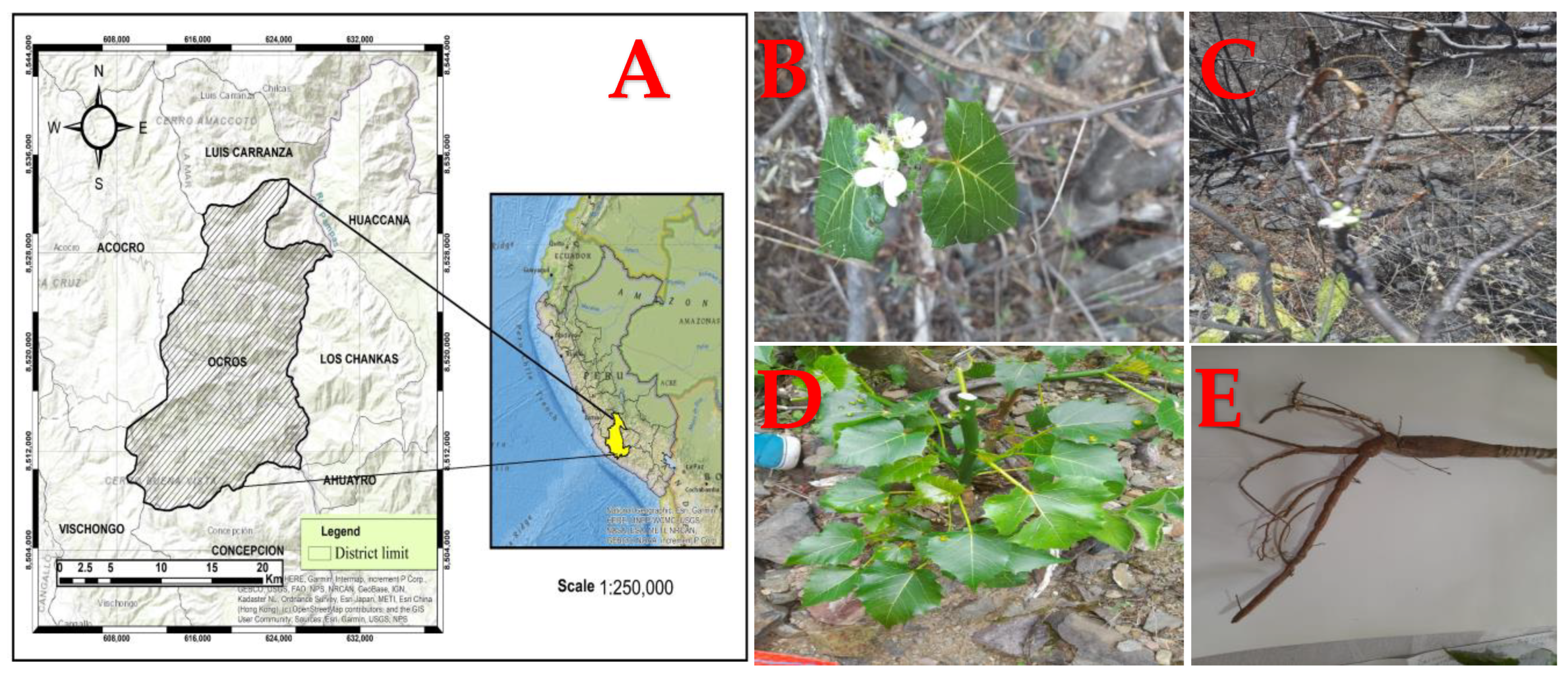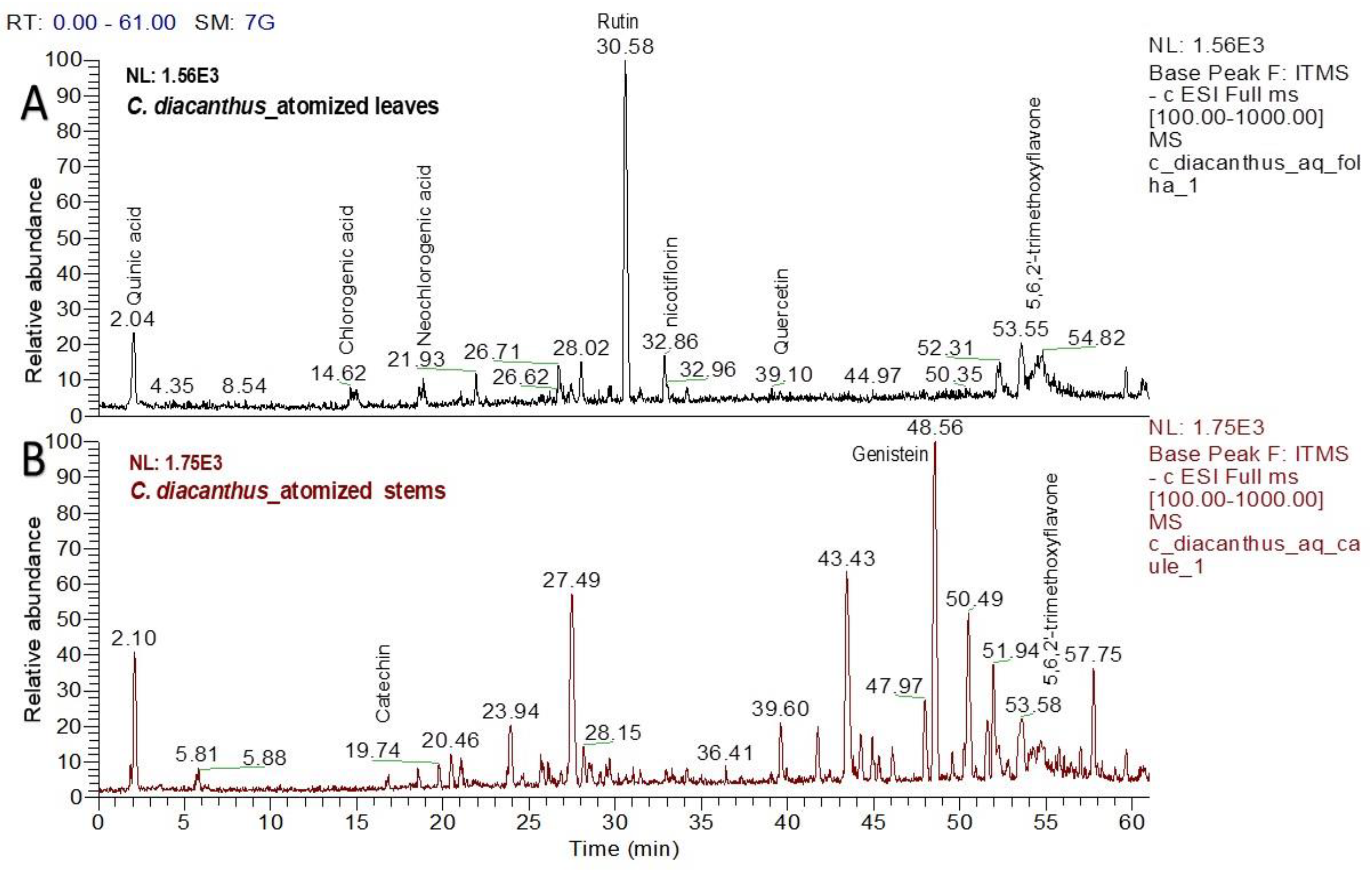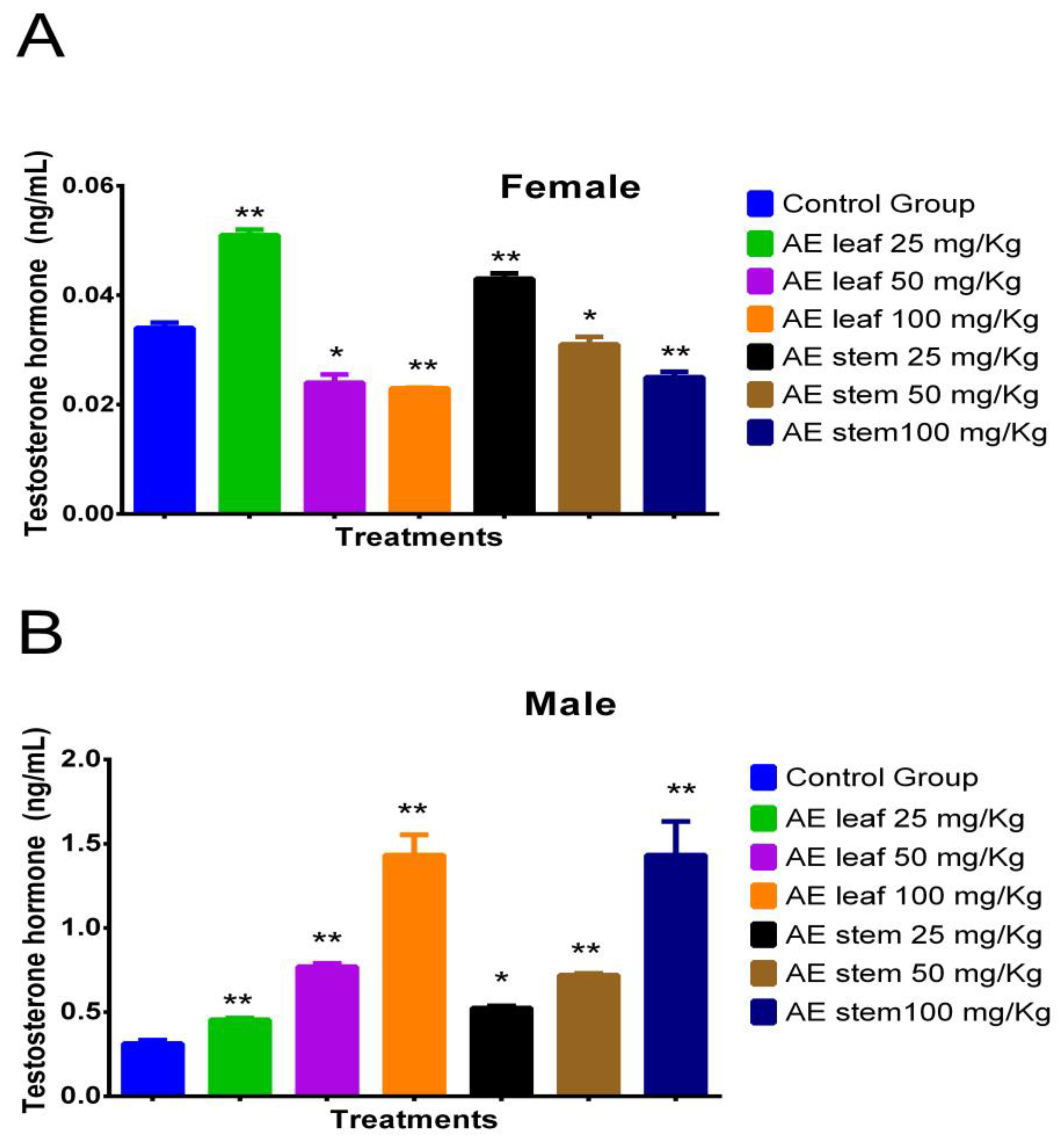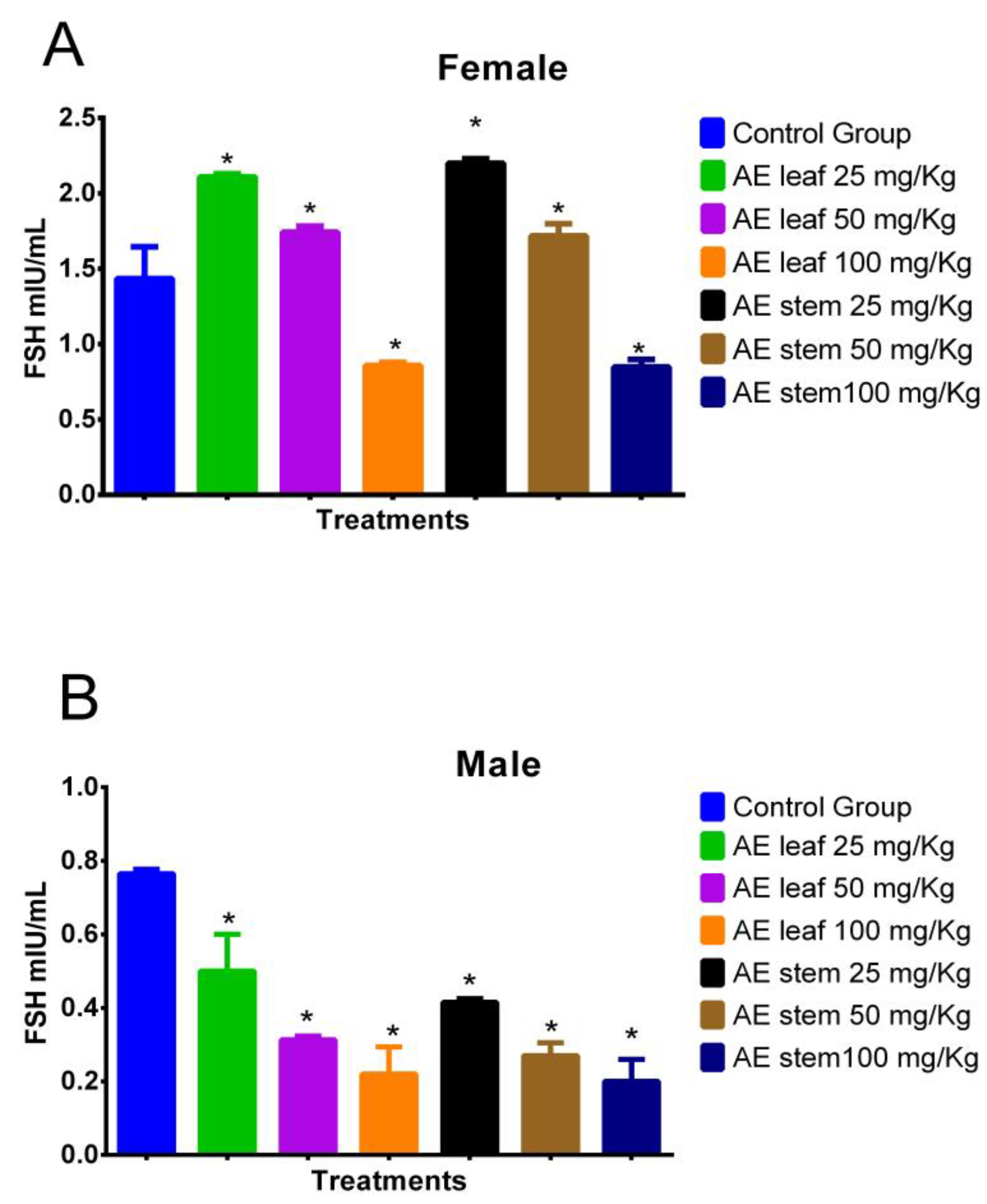The Antioxidant Activity of Atomized Extracts of the Leaves and Stems of Cnidoscolus diacanthus (Pax & K. Hoffm.) J.F. Macbr. from Peru and Their Effect on Sex Hormone Levels in Rats
Abstract
1. Introduction
2. Results
2.1. LC–MS Analysis of the Atomized Extract
2.2. Determination of Total Phenolic Content and Total Flavonoids
2.3. Determination of the Antioxidant Activity
2.4. Hormonal Effect of the Atomized Extract of C. diacanthus
2.4.1. Effect on Testosterone
2.4.2. Effect on Progesterone
2.4.3. Effect on Estradiol (E2)
2.4.4. Effect on Luteinizing Hormone (LH)
2.4.5. Effect on Follicle-Stimulating Hormone (FSH)
3. Discussion
4. Materials and Methods
4.1. Plant Material
4.2. Sample Preparation
4.3. Obtention of the Atomized Extracts from C. diacanthus
4.4. Chemical Characterization by LC–MS
4.4.1. Pretreatment
4.4.2. Chromatographic Conditions
4.5. Determination of the Total Phenolic Content
4.6. Determination of the Flavonoid Content
4.7. Antioxidant Activity of the Atomized Extract of C. diacanthus
4.7.1. The 2,2-diphenyl 1-picrylhydrazyl (DPPH) Free Radical Scavenging Method
4.7.2. Testing Using the 2,2-azinobis-(3-ethylbenzothiazoline)-6-sulfonic Acid (ABTS) Radical Cation Sequestration Method
4.7.3. The Ferric-Reducing Antioxidant Power (FRAP)
4.8. Determination of the Effect of the Atomized Extracts of the Leaves and Stems of Cnidoscolus diacanthus (Pax. & Hoffm.) Macbr. on Hormones in Rats
4.8.1. Animal Conditioning
4.8.2. Preparation of the Extracts
4.8.3. Experimental Design
- −
- Group I: Control group (male rats);
- −
- Group II: Control group (female rats);
- −
- Group III: Atomized leaf extract at a dose of 25 mg/Kg (male rats);
- −
- Group IV: Atomized leaf extract at a dose of 25 mg/Kg (female rats);
- −
- Group V: Atomized leaf extract at a dose of 50 mg/Kg (male rats);
- −
- Group VI: Atomized leaf extract at a dose of 50 mg/Kg (female rats);
- −
- Group VII: Atomized leaf extract at a dose of 100 mg/Kg (male rats);
- −
- Group VIII: Atomized leaf extract at a dose of 100 mg/Kg (female rats);
- −
- Group IX: Atomized stem extract at a dose of 25 mg/Kg (male rats);
- −
- Group X: Atomized stem extract at a dose of 25 mg/Kg (female rats);
- −
- Group XI: Atomized stem extract at a dose of 50 mg/Kg (male rats);
- −
- Group XII: Atomized stem extract at a dose of 50 mg/Kg (female rats);
- −
- Group XIII: Atomized stem extract at a dose of 100 mg/Kg (male rats);
- −
- Group XIV: Atomized stem extract at a dose of 100 mg/Kg (female rats).
4.8.4. Hormonal Evaluation in the Experimental Animals
Testosterone Evaluation
Progesterone Evaluation
Estradiol Evaluation
FSH Evaluation
LH Evaluation
4.9. Statistical Analysis
5. Conclusions
Supplementary Materials
Author Contributions
Funding
Institutional Review Board Statement
Informed Consent Statement
Data Availability Statement
Acknowledgments
Conflicts of Interest
References
- Legese, N.; Tura, A.K.; Roba, K.T.; Demeke, H. The Prevalence of Infertility and Factors Associated with Infertility in Ethiopia: Analysis of Ethiopian Demographic and Health Survey (EDHS). PLoS ONE 2023, 18, e0291912. [Google Scholar] [CrossRef] [PubMed]
- Carson, S.A.; Kallen, A.N. Diagnosis and Management of Infertility: A Review. JAMA 2021, 326, 65–76. [Google Scholar] [CrossRef] [PubMed]
- Awounfack, C.F.; Mvondo, M.A.; Zingue, S.; Ateba, S.B.; Djiogue, S.; Megnekou, R.; Ndinteh, D.T.; Njamen, D. Myrianthus arboreus P. Beauv (Cecropiaceae) Extracts Accelerates Sexual Maturation, and Increases Fertility Index and Gestational Rate in Female Wistar Rats. Medicines 2018, 5, 73. [Google Scholar] [CrossRef] [PubMed]
- Majzoub, A.; Sabanegh, E. Testosterone Replacement in the Infertile Man. Transl. Androl. Urol. 2016, 5, 859–865. [Google Scholar] [CrossRef] [PubMed]
- Musazadeh, V.; Nazari, A.; Natami, M.; Hajhashemy, Z.; Kazemi, K.S.; Torabi, F.; Moridpour, A.H.; Vajdi, M.; Askari, G. The Effect of Flaxseed Supplementation on Sex Hormone Profile in Adults: A Systematic Review and Meta-Analysis. Front. Nutr. 2023, 10, 1222584. [Google Scholar] [CrossRef]
- Boroujeni, S.N.; Malamiri, F.A.; Bossaghzadeh, F.; Esmaeili, A.; Moudi, E. The Most Important Medicinal Plants Affecting Sperm and Testosterone Production: A Systematic Review. JBRA Assist. Reprod. 2022, 26, 522–530. [Google Scholar] [CrossRef]
- Jafari, F.; Khalilzadeh, S.; Nejatbakhsh, F.; Naderi, M. Therapeutic Effects of Garlic (Allium sativum) on Female Reproductive System: A Systematic Review. Heliyon 2023, 9, e22555. [Google Scholar] [CrossRef]
- Wyse, J.; Latif, S.; Gurusinghe, S.; McCormick, J.; Weston, L.A.; Stephen, C.P. Phytoestrogens: A Review of Their Impacts on Reproductive Physiology and Other Effects upon Grazing Livestock. Animals 2022, 12, 2709. [Google Scholar] [CrossRef]
- Noh, S.; Go, A.; Kim, D.B.; Park, M.; Jeon, H.W.; Kim, B. Role of Antioxidant Natural Products in Management of Infertility: A Review of Their Medicinal Potential. Antioxidants 2020, 9, 957. [Google Scholar] [CrossRef]
- Bussmann, R.W.; Glenn, A. Medicinal Plants Used in Northern Peru for Reproductive Problems and Female Health. J. Ethnobiol. Ethnomed. 2010, 6, 30. [Google Scholar] [CrossRef]
- Yakubu, M.T.; Akanji, M.A.; Oladiji, A.T.; Olatinwo, A.W.O.; Adesokan, A.A.; Yakubu, M.O.; Owoyele, B.V.; Sunmonu, T.O.; Ajao, M.S. Effect of Cnidoscolous aconitifolius (Miller) I.M. Johnston Leaf Extract on Reproductive Hormones of Female Rats. Iran J. Reprod. Med. 2008, 6, 149–155. [Google Scholar]
- do Nascimento, J.B.; da Silva, M.I.; da Silva Mendes, J.W.; Dantas, A.R.; Rodrigues, F.F.G.; Montesano, D.; Gallo, M.; Trucillo, P.; Zengin, G.; da Costa, J.G.M. Chemical Composition and Biological Activities of the Cnidoscolus Quercifolis: A Review. Processes 2023, 11, 2203. [Google Scholar] [CrossRef]
- Godínez-Santillán, R.I.; Chávez-Servín, J.L.; García-Gasca, T.; Guzmán-Maldonado, S.H.; Godínez-Santillán, R.I.; Chávez-Servín, J.L.; García-Gasca, T.; Guzmán-Maldonado, S.H. Phenolic Characterization and Antioxidant Capacity of Alcoholic Extracts from Raw and Boiled Leaves of Cnidoscolus aconitifolius (Euphorbiaceae). Acta Bot. Mex. 2019, 126, 1–15. [Google Scholar] [CrossRef]
- Kuri-García, A.; Godínez-Santillán, R.I.; Mejía, C.; Ferriz-Martínez, R.A.; García-Solís, P.; Enríquez-Vázquez, A.; García-Gasca, T.; Guzmán-Maldonado, S.H.; Chávez-Servín, J.L. Preventive Effect of an Infusion of the Aqueous Extract of Chaya Leaves (Cnidoscolus aconitifolius) in an Aberrant Crypt Foci Rat Model Induced by Azoxymethane and Dextran Sulfate Sodium. J. Med. Food 2019, 22, 851–860. [Google Scholar] [CrossRef]
- Moura, L.F.W.G.; da Silva Neto, J.X.; Lopes, T.D.P.; Benjamin, S.R.; Brito, F.C.R.; Magalhães, F.E.A.; Florean, E.O.P.T.; de Sousa, D.d.O.B.; Guedes, M.I.F. Ethnobotanic, Phytochemical Uses and Ethnopharmacological Profile of Genus Cnidoscolus spp. (Euphorbiaceae): A Comprehensive Overview. Biomed. Pharmacother. 2019, 109, 1670–1679. [Google Scholar] [CrossRef]
- Padilla-Camberos, E.; Torres-Gonzalez, O.R.; Sanchez-Hernandez, I.M.; Diaz-Martinez, N.E.; Hernandez-Perez, O.R.; Flores-Fernandez, J.M. Anti-Inflammatory Activity of Cnidoscolus aconitifolius (Mill.) Ethyl Acetate Extract on Croton Oil-Induced Mouse Ear Edema. Appl. Sci. 2021, 11, 9697. [Google Scholar] [CrossRef]
- Panghal, A.; Shaji, A.O.; Nain, K.; Garg, M.K.; Chhikara, N. Cnidoscolus Aconitifolius: Nutritional, Phytochemical Composition and Health Benefits—A Review. Bioact. Compd. Health Dis. 2021, 4, 260–286. [Google Scholar] [CrossRef]
- Pérez-González, M.Z.; Gutiérrez-Rebolledo, G.A.; Yépez-Mulia, L.; Rojas-Tomé, I.S.; Luna-Herrera, J.; Jiménez-Arellanes, M.A. Antiprotozoal, Antimycobacterial, and Anti-Inflammatory Evaluation of Cnidoscolus chayamansa (Mc Vaugh) Extract and the Isolated Compounds. Biomed. Pharmacother. 2017, 89, 89–97. [Google Scholar] [CrossRef]
- Vargas-Madriz, Á.F.; Luzardo-Ocampo, I.; Moreno-Celis, U.; Roldán-Padrón, O.; Chávez-Servín, J.L.; Vergara-Castañeda, H.A.; Martínez-Pacheco, M.; Mejía, C.; García-Gasca, T.; Kuri-García, A. Comparison of Phytochemical Composition and Untargeted Metabolomic Analysis of an Extract from Cnidoscolus aconitifolius (Mill.) I. I. Johnst and Porophyllum ruderale (Jacq.) Cass. and Biological Cytotoxic and Antiproliferative Activity In Vitro. Plants 2023, 12, 1987. [Google Scholar] [CrossRef]
- Pérez-González, M.Z.; Siordia-Reyes, A.G.; Damián-Nava, P.; Hernández-Ortega, S.; Macías-Rubalcava, M.L.; Jiménez-Arellanes, M.A. Hepatoprotective and Anti-Inflammatory Activities of the Cnidoscolus chayamansa (Mc Vaugh) Leaf Extract in Chronic Models. Evid. Based Complement. Alternat. Med. 2018, 2018, 3896517. [Google Scholar] [CrossRef]
- Avila-Nava, A.; Acevedo-Carabantes, J.A.; Alamilla-Martinez, I.; Tobón-Cornejo, S.; Torre-Villalvazo, I.; Tovar, A.R.; Torres, N.; Noriega, L.G. Chaya (Cnidoscolus aconitifolius (Mill.) I.M. Johnst) Leaf Extracts Regulate Mitochondrial Bioenergetics and Fatty Acid Oxidation in C2C12 Myotubes and Primary Hepatocytes. J. Ethnopharmacol. 2023, 312, 116522. [Google Scholar] [CrossRef] [PubMed]
- Zambrano-Vázquez, A.; René, O.; Contreras, A.; Barbo, L.; Adelina, M. Actividad Antiinflamatoria, Antioxidante y Antimicrobiana Del Extracto Orgánico de Cnidoscolus Tehuacanensis Breckon y Su Fraccionamiento Químico. Rev. Mex. Cienc. Farm. 2017, 48, 56–66. [Google Scholar]
- Us-Medina, U.; Millán-Linares, M.D.C.; Arana-Argaes, V.E.; Segura-Campos, M.R. In Vitro Antioxidant and Anti-Inflammatory Activity of Chaya Extracts (Cnidoscolus aconitifolius (Mill.) I.M. Johnst). Nutr. Hosp. 2020, 37, 46–55. [Google Scholar] [CrossRef]
- Mishra, P.; Mishra, S.; Mahanta, C.L. Effect of Maltodextrin Concentration and Inlet Temperature during Spray Drying on Physicochemical and Antioxidant Properties of Amla (Emblica officinalis) Juice Powder. Food Bioprod. Process. 2014, 92, 252–258. [Google Scholar] [CrossRef]
- Loarca-Piña, G.; Mendoza, S.; Ramos-Gómez, M.; Reynoso, R. Antioxidant, Antimutagenic, and Antidiabetic Activities of Edible Leaves from Cnidoscolus chayamansa Mc. Vaugh. J. Food Sci. 2010, 75, H68–H72. [Google Scholar] [CrossRef]
- García-Rodríguez, R.V.; Gutiérrez-Rebolledo, G.A.; Méndez-Bolaina, E.; Sánchez-Medina, A.; Maldonado-Saavedra, O.; Domínguez-Ortiz, M.Á.; Vázquez-Hernández, M.; Muñoz-Muñiz, O.D.; Cruz-Sánchez, J.S. Cnidoscolus chayamansa Mc Vaugh, an Important Antioxidant, Anti-Inflammatory and Cardioprotective Plant Used in Mexico. J. Ethnopharmacol. 2014, 151, 937–943. [Google Scholar] [CrossRef] [PubMed]
- Krishnaiah, D.; Nithyanandam, R.; Sarbatly, R. A Critical Review on the Spray Drying of Fruit Extract: Effect of Additives on Physicochemical Properties. Crit. Rev. Food Sci. Nutr. 2014, 54, 449–473. [Google Scholar] [CrossRef] [PubMed]
- Nguyen, Q.D.; Dang, T.T.; Nguyen, T.V.L.; Nguyen, T.T.D.; Nguyen, N.N. Microencapsulation of Roselle (Hibiscus sabdariffa L.) Anthocyanins: Effects of Drying Conditions on Some Physicochemical Properties and Antioxidant Activities of Spray-Dried Powder. Food Sci. Nutr. 2022, 10, 191–203. [Google Scholar] [CrossRef] [PubMed]
- Baliyan, S.; Mukherjee, R.; Priyadarshini, A.; Vibhuti, A.; Gupta, A.; Pandey, R.P.; Chang, C.M. Determination of Antioxidants by DPPH Radical Scavenging Activity and Quantitative Phytochemical Analysis of Ficus Religiosa. Molecules 2022, 27, 1326. [Google Scholar] [CrossRef]
- Mega, O.O.; Benneth, B.A.; Edesiri, T.P.; Rume, R.A.; Victor, E.; Rotu, R.A.; Oghenetega, B.O.; Agbonifo-Chijiokwu, E.; Kingsley, N.E.; Andrew, U.O.; et al. Possible Mechanisms Involved in the Testicular-Protective Property of Quercetin in Rats Exposed to Endosulfan Toxicity. Pestic. Biochem. Physiol. 2022, 188, 105224. [Google Scholar] [CrossRef]
- Yu, P.L.; Pu, H.F.; Chen, S.Y.; Wang, S.W.; Wang, P.S. Effects of Catechin, Epicatechin and Epigallocatechin Gallate on Testosterone Production in Rat Leydig Cells. J. Cell. Biochem. 2010, 110, 333–342. [Google Scholar] [CrossRef] [PubMed]
- Ferigolo, M.; Nardi, J.; Freddo, N.; Ferramosca, A.; Zara, V.; Dallegrave, E.; Macedo, M.B.; Eller, S.; de Oliveira, A.P.; Biazus, I.C.; et al. Evaluation of Genistein as a Mitochondrial Modulator and Its Effects on Sperm Quality. Int. J. Mol. Sci. 2023, 24, 14260. [Google Scholar] [CrossRef] [PubMed]
- Martin, L.J.; Touaibia, M. Prevention of Male Late-Onset Hypogonadism by Natural Polyphenolic Antioxidants. Nutrients 2024, 16, 1815. [Google Scholar] [CrossRef] [PubMed]
- Li, Z.; Yang, P.; Xue, S.; Yuan, S.; Yuan, L.; Yan, R.; Tang, D.; Li, J. Testosterone Promotion Effect of Eucommia Ulmoides Staminate Flower via the Steroidogenic Pathway and Potential Hormonal Mechanism. Sci. Rep. 2022, 12, 18765. [Google Scholar] [CrossRef]
- Kiyama, R. Estrogenic Flavonoids and Their Molecular Mechanisms of Action. J. Nutr. Biochem. 2023, 114, 109250. [Google Scholar] [CrossRef]
- Slighoua, M.; Amrati, F.E.Z.; Chebaibi, M.; Mahdi, I.; Al Kamaly, O.; El Ouahdani, K.; Drioiche, A.; Saleh, A.; Bousta, D. Quercetin and Ferulic Acid Elicit Estrogenic Activities In Vivo and In Silico. Molecules 2023, 28, 5112. [Google Scholar] [CrossRef]
- Guo, X.D.; Diao, Q.Y.; Wang, Y.Y.; Tu, Y.; Deng, K.D.; Wang, X.J.; Fu, T.; Yan, G.L. The Effect of Administration of Rutin on Plasma Levels of Estrogen, Prolactin, Growth Hormone and Gene Expression of Their Receptors in Mammary Glands in Ovariectomized Rats. J. Integr. Agric. 2012, 11, 1700–1706. [Google Scholar] [CrossRef]
- Rodríguez-Landa, J.F.; Cueto-Escobedo, J.; Puga-Olguín, A.; Rivadeneyra-Domínguez, E.; Bernal-Morales, B.; Herrera-Huerta, E.V.; Santos-Torres, A. The Phytoestrogen Genistein Produces Similar Effects as 17 β -Estradiol on Anxiety-like Behavior in Rats at 12 Weeks after Ovariectomy. Biomed. Res. Int. 2017, 2017, 9073816. [Google Scholar] [CrossRef]
- Patel, S.; Peretz, J.; Pan, Y.X.; Helferich, W.G.; Flaws, J.A. Genistein Exposure Inhibits Growth and Alters Steroidogenesis in Adult Mouse Antral Follicles. Toxicol. Appl. Pharmacol. 2016, 293, 53. [Google Scholar] [CrossRef]
- Moroole, M.A.; Materechera, S.A.; Mbeng, W.O.; Aremu, A.O. Medicinal Plants Used for Contraception in South Africa: A Review. J. Ethnopharmacol. 2019, 235, 19–27. [Google Scholar] [CrossRef]
- Abedpour, N.; Javanmard, M.Z.; Karimipour, M.; Liqvan, A.P. Effect of Chlorogenic Acid on Follicular Development, Hormonal Status and Biomarkers of Oxidative Stress in Rats with Polycystic Ovary Syndrome. Vet. Res. Forum 2022, 13, 513–520. [Google Scholar] [CrossRef] [PubMed]
- Ajayi, A.; Akhigbe, R. Antifertility Activity of Cryptolepis sanguinolenta Leaf Ethanolic Extract in Male Rats. J. Hum. Reprod. Sci. 2012, 5, 43–47. [Google Scholar] [CrossRef] [PubMed]
- Fofie Tedongmo, A.D.; Mvondo, M.A. Allium ampeloprasum Var. Porrum (Alliaceae) Improves Metabolic and Reproductive Disorders Associated with Polycystic Ovary Syndrome in Wistar Rats. Biochem. Res. Int. 2024, 2024, 8364343. [Google Scholar] [CrossRef]
- Ramya, S.; Poornima, P.; Jananisri, A.; Geofferina, I.P.; Bavyataa, V.; Divya, M.; Priyanga, P.; Vadivukarasi, J.; Sujitha, S.; Elamathi, S.; et al. Role of Hormones and the Potential Impact of Multiple Stresses on Infertility. Stresses 2023, 3, 454–474. [Google Scholar] [CrossRef]
- Chirinos, R.; Pedreschi, R.; Rogez, H.; Larondelle, Y.; Campos, D. Phenolic Compound Contents and Antioxidant Activity in Plants with Nutritional and/or Medicinal Properties from the Peruvian Andean Region. Ind. Crops Prod. 2013, 47, 145–152. [Google Scholar] [CrossRef]
- AL-Oraimi, A.A.; Hossain, M.A. In Vitro Total Flavonoids Content and Antimicrobial Capacity of Different Organic Crude Extracts of Dodonaea viscosa. J. Biol. Act. Prod. Nat. 2016, 6, 150–165. [Google Scholar] [CrossRef]
- Kozmelj, T.R.; Voinov, M.A.; Grilc, M.; Smirnov, A.I.; Jasiukaitytė-Grojzdek, E.; Lucia, L.; Likozar, B. Lignin Structural Characterization and Its Antioxidant Potential: A Comparative Evaluation by EPR, UV-Vis Spectroscopy, and DPPH Assays. Int. J. Mol. Sci. 2024, 25, 9044. [Google Scholar] [CrossRef] [PubMed]
- Re, R.; Pellegrini, N.; Proteggente, A.; Pannala, A.; Yang, M.; Rice-Evans, C. Antioxidant Activity Applying an Improved ABTS Radical Cation Decolorization Assay. Free Radic. Biol. Med. 1999, 26, 1231–1237. [Google Scholar] [CrossRef] [PubMed]
- Enciso-Roca, E.C.; Aguilar-Felices, E.J.; Tinco-Jayo, J.A.; Arroyo-Acevedo, J.L.; Herrera-Calderon, O. Biomolecules with Antioxidant Capacity from the Seeds and Sprouts of 20 Varieties of Chenopodium quinoa Willd. (Quinoa). Plants 2021, 10, 2417. [Google Scholar] [CrossRef]
- Rossi, A.G.Z.; Teixeira Gomes, R.C.; de Jesus Simões, M.; dos Santos Simões, R.; Oliveira, P.B.; Soares, J.M.; Baracat, E.C. Effects of Metoclopramide-Induced Hyperprolactinemia on the Prolactin Receptor of Murine Endometrium. Fertil. Steril. 2010, 93, 1643–1649. [Google Scholar] [CrossRef]
- Uhuo, E.N.; Nwuke, C.P.; Oriaku, C.E.; Chilaka, J.O. Biochemical and Hormonal Parameters Analysis of Metoclopramide-Induced Hyperprolactinemic Female Wistar Rats Administered Leaf Extract of Kigelia africana. Clin. Nutr. Open Sci. 2021, 36, 151–162. [Google Scholar] [CrossRef]







| Assigned Identification | Molecular Formula (m/z) [M-H]− | Retention Time (min) | Product Ions (MS2) |
|---|---|---|---|
| Quinic acid [13] | C7H12O6 191.08 | 2.04 | 173 (–H2O), 127 (–HCO2H), 85 (100%) |
| Chlorogenic acid (3-O-caffeoylquinic acid) [13,14] | C16H18O9 352.91 | 14.62 | 191 (100%), 179, 173 |
| Neochlorogenic acid (5-O-caffeoylquinic acid) [14] | C16H18O9 352.81 | 21.93 | 191, 179, 173 (100%), 135, 107 |
| Quercetin 3-rhamnoglucoside (rutin) [15] | C27H30O16 609.01 | 30.58 | 463 (–dHex), 301 (100%) (–dHex–Hex = quercetin), 271 |
| Kaempferol 3-O-glucoside-7-O-rhamnoside (nicotiflorin) [15] | C27H30O15 593.05 | 32.86 | 447 (–dHex), 327, 285 (100%) (–dHex–Hex = kaempferol) |
| Quercetin [16] | C15H10O7 301.03 | 39.49 | 283, 257, 165 (100%), 135, 91 |
| 5,6,2′-trimethoxyflavone (N.R.) | C18H16O5 311.17 | 53.55 | 197, 183 (100%), 170, 119 |
| Assigned Identification | Molecular Formula (m/z) [M-H]− | Retention Time (min) | Product Ions (MS2) |
|---|---|---|---|
| Catechin [17] | C15H14O6 289.13 | 19.74 | 271, 245 (100%), 205, 179 |
| Genistein (N.R.) | C15H10O5 269.12 | 48.56 | 251, 241 (100%), 213, 201 |
| 5,6,2-Trimethoxyflavone (N.R.) | C18H16O5 311.17 | 53.58 | 197, 183 (100%), 170, 119 |
| Atomized Extract | Total Phenols (mg GAE/g Extract) | Total Flavonoids (mg QE/g Extract) | Correlation Flavonoids/Phenols |
|---|---|---|---|
| Leaves | 212.38 ± 3.19 * | 121.49 ± 2.69 * | 0.57 |
| Stems | 464.38 ± 4.40 * | 369.17 ± 3.16 * | 0.79 |
| Antioxidant Assay | Atomized Extract * | Antioxidant Standard | p Value (Student’s t-Test) | ||
|---|---|---|---|---|---|
| Leaves | Stems | Trolox | |||
| DPPH | µmol TE/mg extract | 462.39 ± 2.0 | 597.20 ± 2.32 | - | p < 0.0001 |
| IC50 (µg/mL) | 922.04 | 841.95 | 3.24 ± 0.01 | ||
| ABTS | µmol TE/mg extract | 202.32 ± 5.76 | 452.67 ± 5.20 | - | p < 0.0001 |
| IC50 (µg/mL) | 1396.09 | 678.70 | 2.36 ± 0.03 | ||
| FRAP | µmol TE/mg extract | 198.13 ± 1.44 | 535.91 ± 1.56 | - | p < 0.0001 |
Disclaimer/Publisher’s Note: The statements, opinions and data contained in all publications are solely those of the individual author(s) and contributor(s) and not of MDPI and/or the editor(s). MDPI and/or the editor(s) disclaim responsibility for any injury to people or property resulting from any ideas, methods, instructions or products referred to in the content. |
© 2024 by the authors. Licensee MDPI, Basel, Switzerland. This article is an open access article distributed under the terms and conditions of the Creative Commons Attribution (CC BY) license (https://creativecommons.org/licenses/by/4.0/).
Share and Cite
Tinco-Jayo, J.A.; Pérez-Chauca, L.F.; Castilla-Torres, N.V.; Enciso-Roca, E.C.; Taboada-Huaman, D.; Nuñez-Soto, L.; Moscoso-García, L.U.; Arroyo-Acevedo, J.L.; Aguilar-Felices, E.J.; Herrera-Calderon, O. The Antioxidant Activity of Atomized Extracts of the Leaves and Stems of Cnidoscolus diacanthus (Pax & K. Hoffm.) J.F. Macbr. from Peru and Their Effect on Sex Hormone Levels in Rats. Molecules 2024, 29, 4554. https://doi.org/10.3390/molecules29194554
Tinco-Jayo JA, Pérez-Chauca LF, Castilla-Torres NV, Enciso-Roca EC, Taboada-Huaman D, Nuñez-Soto L, Moscoso-García LU, Arroyo-Acevedo JL, Aguilar-Felices EJ, Herrera-Calderon O. The Antioxidant Activity of Atomized Extracts of the Leaves and Stems of Cnidoscolus diacanthus (Pax & K. Hoffm.) J.F. Macbr. from Peru and Their Effect on Sex Hormone Levels in Rats. Molecules. 2024; 29(19):4554. https://doi.org/10.3390/molecules29194554
Chicago/Turabian StyleTinco-Jayo, Johnny Aldo, León Fernando Pérez-Chauca, Nancy Victoria Castilla-Torres, Edwin Carlos Enciso-Roca, Diana Taboada-Huaman, Litman Nuñez-Soto, Luis Uriel Moscoso-García, Jorge Luis Arroyo-Acevedo, Enrique Javier Aguilar-Felices, and Oscar Herrera-Calderon. 2024. "The Antioxidant Activity of Atomized Extracts of the Leaves and Stems of Cnidoscolus diacanthus (Pax & K. Hoffm.) J.F. Macbr. from Peru and Their Effect on Sex Hormone Levels in Rats" Molecules 29, no. 19: 4554. https://doi.org/10.3390/molecules29194554
APA StyleTinco-Jayo, J. A., Pérez-Chauca, L. F., Castilla-Torres, N. V., Enciso-Roca, E. C., Taboada-Huaman, D., Nuñez-Soto, L., Moscoso-García, L. U., Arroyo-Acevedo, J. L., Aguilar-Felices, E. J., & Herrera-Calderon, O. (2024). The Antioxidant Activity of Atomized Extracts of the Leaves and Stems of Cnidoscolus diacanthus (Pax & K. Hoffm.) J.F. Macbr. from Peru and Their Effect on Sex Hormone Levels in Rats. Molecules, 29(19), 4554. https://doi.org/10.3390/molecules29194554








